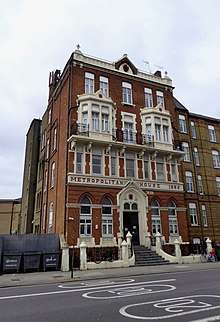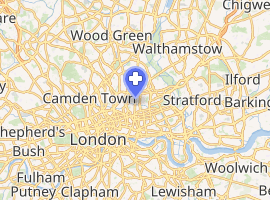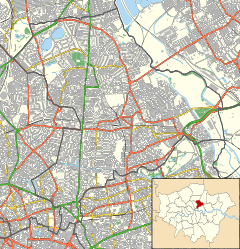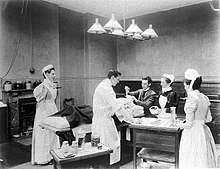Metropolitan Free Hospital
The Metropolitan Free Hospital was a London hospital, founded in 1836 and based for most of its existence in Kingsland Road, Hackney. It became part of the NHS in 1948, and closed in 1977, with its residual functions transferring to Barts Hospital.
| Metropolitan Free Hospital | |
|---|---|
| City and Hackney (Teaching) District Health Authority | |
 Metropolitan Free Hospital | |

| |
 Location within Hackney | |
| Geography | |
| Location | Kingsland Road, Hackney. |
| Coordinates | 51°32′26.01″N 0°4′36.16″W |
| Organisation | |
| Care system | NHS England |
| Services | |
| Emergency department | No |
| History | |
| Opened | 1836 |
| Closed | 1977 |
History

Early years
The hospital was founded by Jonathan Fry, a son of Elizabeth Fry, to provide medical treatment for the destitute, in 1836.[1][2] Its mission was ‘to grant immediate relief to the sick poor of every nation and class whatever may be their diseases, on presenting themselves to the charity without letter of recommendation; such letters being always procured with difficulty and often after dangerous delay’.[3] It was based initially at 29 Carey Street, near Lincoln's Inn, previously the home of the silversmith Richard Cooke.[4] In 1843, Prince Adolphus, Duke of Cambridge sponsored its first inpatient beds.[1]
In 1850, the hospital moved to 8 Devonshire Square, Bishopsgate, and soon after began to treat inpatients.[1] However, in the 1870s, the Devonshire Square site was wanted by the Great Eastern Railway Company to extend their London terminus, Liverpool Street Station.[1] The hospital sold its premises to the railway for £8,500 in 1876.[1] It moved to 81 Commercial Street, Spitalfields and remained there until 1885 when it found a suitable site on the Kingsland Road.[1]
Kingsland Road
The hospital operated from a series of buildings on Kingsland Road while a dedicated building was being constructed between 1885 and 1886. Under its new governor, Sir Edmund Hay Currie, it began to charge a small subscription, and so dropped the word ‘Free’ from its title.[1] As the Metropolitan Hospital, it formed a partnership with Anglican nursing order, the Order of All Saints.[1] In 1902 King Edward VII became its patron.[1] The hospital developed specialist services, including a dedicated ward for Jewish patients, and expertise in treating tuberculosis.[5] In 1948 the Metropolitan Hospital became part of the National Health Service.[1] After services were transferred to Barts Hospital, the hospital closed in 1977.[1] The building was subsequently converted for use as a business centre and as a hostel.[6]
References
- "Metropolitan Hospital, 359 Kingsland Road, Dalston,E8 4DS". Lost Hospitals of London. Retrieved 25 June 2018.
- "Metropolitan Hospital, London". National Archives. Retrieved 25 June 2018.
- "The Development of the London Hospital System: the Voluntary Hospitals". NHS History net. Retrieved 25 June 2018.
- "Richard Cooke". Koopman Rare Art. Retrieved 25 June 2018.
- "Metropolitan Hospital". Barts and the London. Retrieved 25 June 2018.
- "Hotel planners just love Hackney". Loving Dalston. Retrieved 25 June 2018.